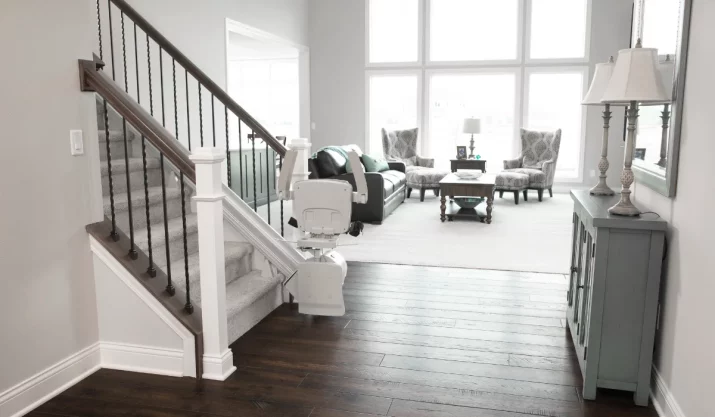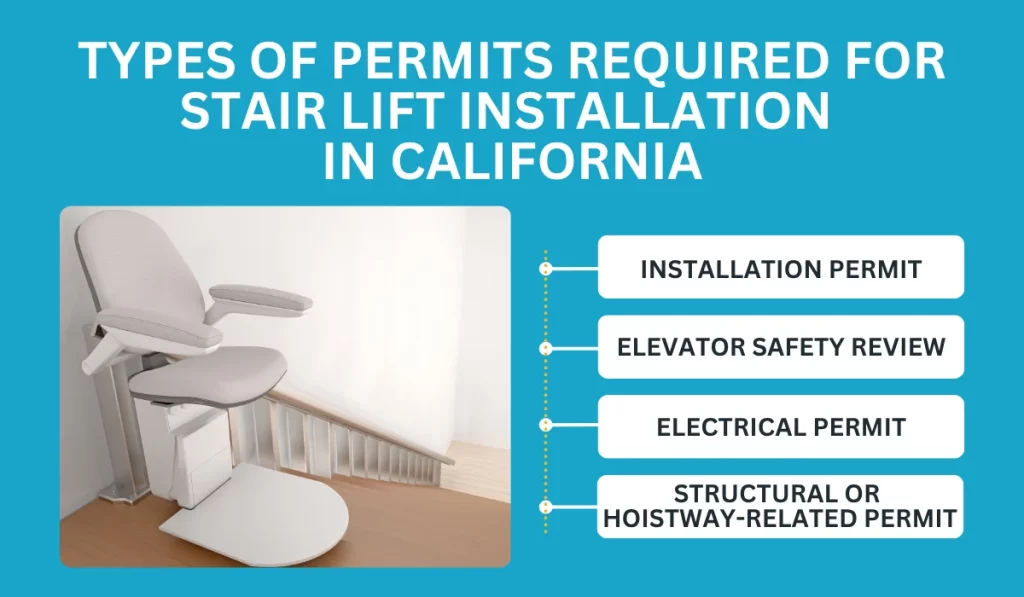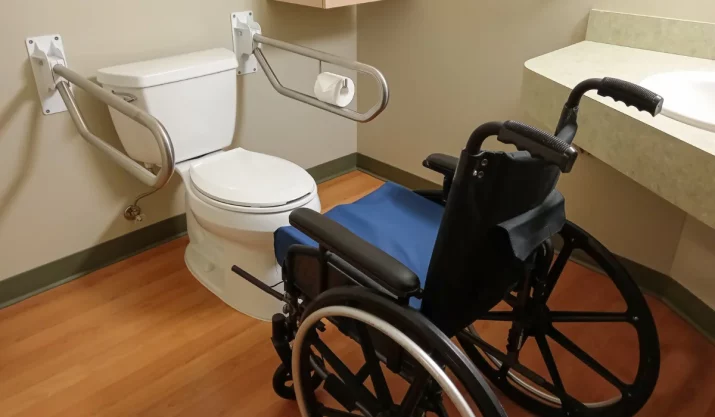Do You Need a Permit to Install a Stair Lift in California?

Table of Contents
If you’re thinking about installing a stair lift in your California home, you’re not alone. Whether you’re aging in place or accommodating a loved one with mobility issues, a stairway chairlift or platform lift can make a huge difference in daily life.
But here’s what many homeowners don’t realize: a permit is usually required in California before installation.
In this guide, you’ll learn exactly what types of permits apply, how much they cost, and what can go wrong if you skip them.
Key Takeaways
- A stair lift in California needs permits to meet safety rules, building codes, and installation inspection requirements.
- Permit fees depend on your location and may include application, inspection, reinspection, and structural plan review costs.
- Skipping permits can lead to fines, delayed home sales, insurance problems, and losing your lift’s service warranty.
- California Mobility helps you file permits, pass inspections, and stay compliant with California Code of Regulations standards.
Types of Permits Required for Stair Lift Installation in California

If you’re installing a stair lift in California, you’ll need the right permits in place before work begins. From structural changes to electrical hookups, here are the types of permits most homeowners need to plan for:
Installation Permit
For most homes, a stair lift qualifies as an alteration that requires an installation permit. In a private residence, this ensures compliance with both local building code and state regulations like the California Code of Regulations.
You’ll typically need to show specs like lift speed, rail mounting, and how the equipment will interface with handrails, walls, or landings.
Elevator Safety Review
California includes stairway chairlifts, wheelchair lifts, and vertical platform lifts under its broader home elevator safety umbrella.
The Department of Industrial Relations, which oversees these systems, may require an inspection depending on the lift’s size, power, or hoistway configuration.
Even in homes, if your stair lift functions similarly to an inclined elevator or material lift, expect to meet the same scrutiny you’d find with freight elevators or manlifts.
Electrical Permit
If your stair lift or dumbwaiter taps into the home’s electrical supply, your contractor will need an electrical permit.
California’s Labor Code mandates strict electrical standards, particularly in Los Angeles, San Diego, and other large jurisdictions. Whether the lift is battery-operated or hardwired, you’ll still need inspection clearance.
Structural or Hoistway-Related Permit
If your installation requires modifying a hoistway, cutting into walls, or reinforcing stairs to support a counterweight or track system, a structural permit may be triggered.
In older San Francisco homes, for example, reinforcing for a vertical platform lift often requires notching through existing framing or modifying stair handrails, which brings the full weight of ASME A18.1 and ASME A17.1 standards into play.
Permit Fees You May Have to Pay
Every permit step comes with its price tag.
Whether you’re in San Francisco or Los Angeles, here are the common fees you’ll run into when installing a stair lift in California:
City Permit Application Fee
The cost of a stair lift permit starts with the permit issuance fee.
In California cities like Los Angeles or San Francisco, this varies by project size and scope. Even for a stair lift in a private residence, expect this fee to range from $100 to $250, sometimes more if plans involve structural modification.
Inspection Fees
Multiple inspections may be required, especially if you’re installing a wheelchair lift, adjusting power sources, or modifying walls.
Local jurisdictions charge inspection fees for each visit. These can climb if you’re in an area where reinspection is common due to construction backlogs.
Plan Check or Engineering Fees
If your project involves structural engineering, like reinforcing for a platform lift or retrofitting in tight quarters near a moving walk or shared stairwell, then your city will likely charge a plan check fee.
This covers review time to ensure your lift complies with every applicable safety standard and doesn’t interfere with other systems in your home or building.
Reinspection or Resubmittal Fees
Changes during the install process?
You may need to resubmit your plans for review.
In municipalities like Los Angeles, these permit fees can include resubmittal charges if you revise after issuance, and reinspection charges if the first pass doesn’t meet standards.
What Happens if You Skip the Permit?
If you install a stair lift without a permit, you’re not just bending the rules; you’re taking on real risks. Here’s what can happen when you skip the process:
Code Violations and Fines
Skipping the permit required process might seem like a shortcut, but it can backfire. California inspectors are serious about building code compliance, especially for devices tied to elevator safety.
If you’re caught with unpermitted work, you could face fines, mandatory removal, and retroactive permit costs, plus the hassle of stopping work mid-project.
Insurance Issues
Without proper documentation, your home insurance might not cover injuries, property damage, or accidents involving your stair lift.
If your lift shares structural elements with a manlift, dumbwaiter, or even a custom material lift, insurers may treat it as specialized equipment, requiring you to prove it passed inspection.
Real Estate Complications
Homes with unpermitted installations can face delays during sale or refinance.
In competitive markets like Los Angeles or San Francisco, buyers often request permit documentation for additions like a stairway chairlift or vertical platform lift.
If you can’t provide proof of approval, you may need to pay to legalize the work before closing escrow.
Warranty Voidance
If your stair lift isn’t properly permitted or inspected, you could lose your warranty rights. Most manufacturers and third-party installers require proof of code-compliant installation for their service contract or maintenance service to remain valid.
Without that paperwork, you may be stuck with costly repairs down the road.
Get Help Navigating Stair Lift Permits in California
California’s permit process might feel overwhelming, but you don’t have to face it alone.
At California Mobility, we specialize in navigating the permit process for stair lifts, inclined elevators, and vertical platform lifts across the state, from San Francisco’s steep Victorian staircases to Los Angeles’ multi-level ranch homes.
We’ll handle every detail: the paperwork, the inspections, and making sure your lift complies with the California Code of Regulations, ASME A18.1, and A17.1 safety standards.
Contact us today to get your stair lift project started the right way, permit-ready, code-compliant, and built for life in California.






